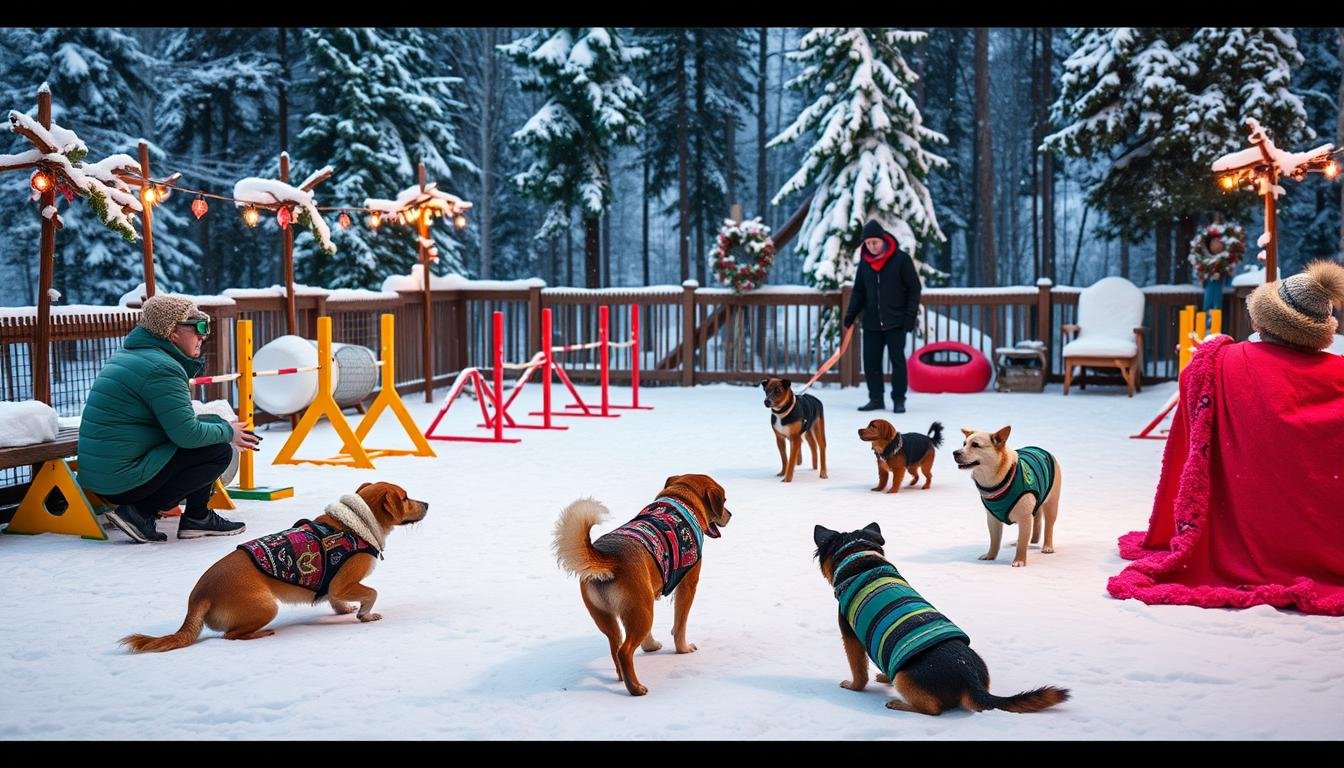When winter hits, it’s not just about dressing warmly. It’s also about keeping your dog’s training on track. Gone are the days of playing fetch in the sun. Now, icy winds might make you and your dog want to stay inside.
But, there are real tips for training your dog in winter. These strategies are key to keeping your dog happy and safe. They help your dog stay mentally and physically active, even in the cold.
Training your dog in the cold is tough. It tests your bond and determination. You can let the snow get you down, or you can use it to strengthen your dog’s training.
This guide will help you keep your dog’s spirits high, even when it’s cold. You’ll see your dog’s skills and health improve in the winter. Let’s get ready to face the winter together, with strategies that make your dog winter-ready.
Quick Recommendation. Our blog is filled with tips and tricks for training your puppy or dog. If you’re seeking a comprehensive online training program, we recommend K9 Training Institute.
Understanding the Challenges of Winter Dog Training
When it gets colder, winter dog training challenges become more common. You’ll need to change your training plans and how you do things. The snow is beautiful, but it also makes training harder.
Dogs can act differently in the cold. They might not want to go outside as much. They might also get distracted by the snow and ice.
This can make training harder. Dogs might seem tired or restless. They might not want to do their training.
Shorter days also make it hard to train outside. You need daylight for training. But the cold weather can make it hard to stay outside.
Sleet, snow, and ice can also be a problem. They can make training outside risky. It can hurt you or your dog.
To keep your dog active, try indoor training. You can also change outdoor activities to keep them safe. This way, your dog stays active and healthy.
It’s important to adjust to the cold weather. This helps keep your dog’s training going. It also keeps them safe and happy during the winter.
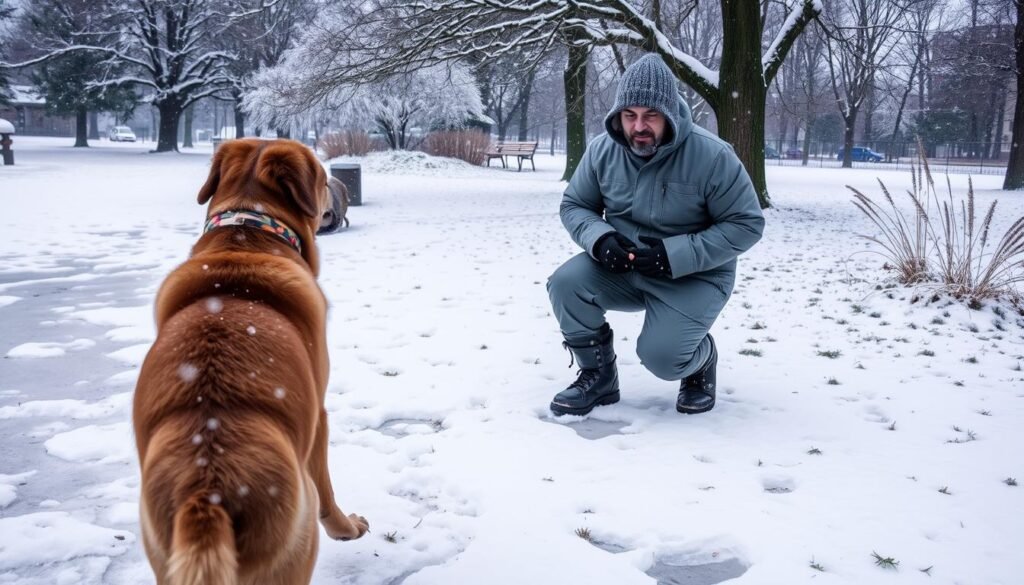
Preparing Your Dog for the Cold
As temperatures drop, it’s vital to focus on winterizing your dog. Getting your furry friend ready for winter boosts their comfort and safety. Here’s how to start with the right dog winter gear and steps to protect them.

First, pick the right dog winter gear. A well-fitting coat and waterproof boots are key. They keep your dog warm and prevent ice from hurting their paws. Make sure the coat fits right and the boots have good grip.
Also, take care of your dog’s paws. Check for cracks or redness and use a safe paw balm. Clean their paws after walks to avoid harmful substances like rock salt and antifreeze.
Lastly, manage your dog’s outdoor time. Short walks and a warm spot inside are best. Keep them hydrated and maybe add more food if they’re cold.
Remembering these tips will help you winterize your dog well. They’ll stay happy and healthy all winter.
Maintaining Your Dog’s Exercise Routine
As winter comes, it can be hard to keep dogs active in the cold. But, it’s vital to keep your pet’s body and mind sharp through dog exercise in winter. Here are some great ways to keep your furry friend moving and happy in the cold.
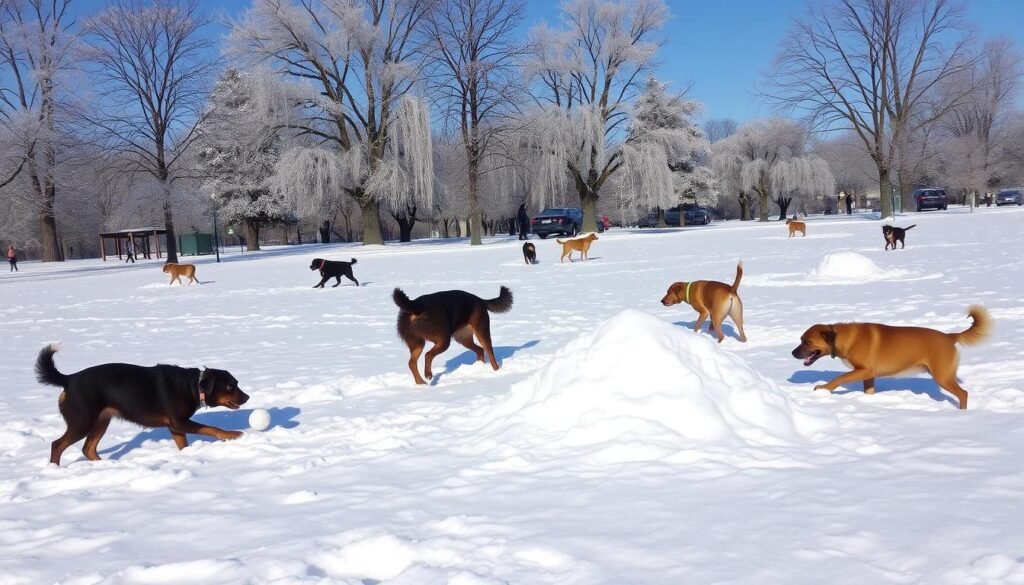
Start by changing up outdoor play. Winter workouts can be fun for both you and your dog. Try snowball fetch, short hikes, or jogging in light snow. Make sure your dog wears booties and a waterproof coat to stay warm and dry.
When it’s too cold outside, indoor play is the way to go. Use interactive toys, set up obstacle courses, or teach new tricks. This keeps your dog active and sharp, making indoor play just as good as outdoor.
Adding these activities to your winter routine keeps your dog healthy and happy. Being consistent is important. Mix indoor and outdoor play to keep your dog fit all year.
Quick Recommendation. Our blog is filled with tips and tricks for training your puppy or dog. If you’re seeking a comprehensive online training program, we recommend K9 Training Institute.
Indoor Training Activities and Games
When it’s cold outside, indoor dog training is a great way to keep your dog happy and smart. Interactive dog training and dog brain games are fun and keep your dog’s mind sharp. Here are some fun activities you can do at home.
The shell game is a great way to improve your dog’s thinking skills. You hide a treat under a cup, then move the cups around. This game helps your dog learn to focus and solve problems. It’s a key part of dog brain games that gets harder as your dog gets better.
Teaching new tricks or practicing old ones is another fun indoor activity. Tricks like ‘speak,’ ‘spin,’ or ‘play dead’ are great for interactive dog training. They make training sessions fun and strengthen your bond with your dog.
Interactive treat-dispensing toys are also great for mental and physical exercise. These toys release treats as your dog plays with them. They’re perfect for keeping your dog’s mind and body active.
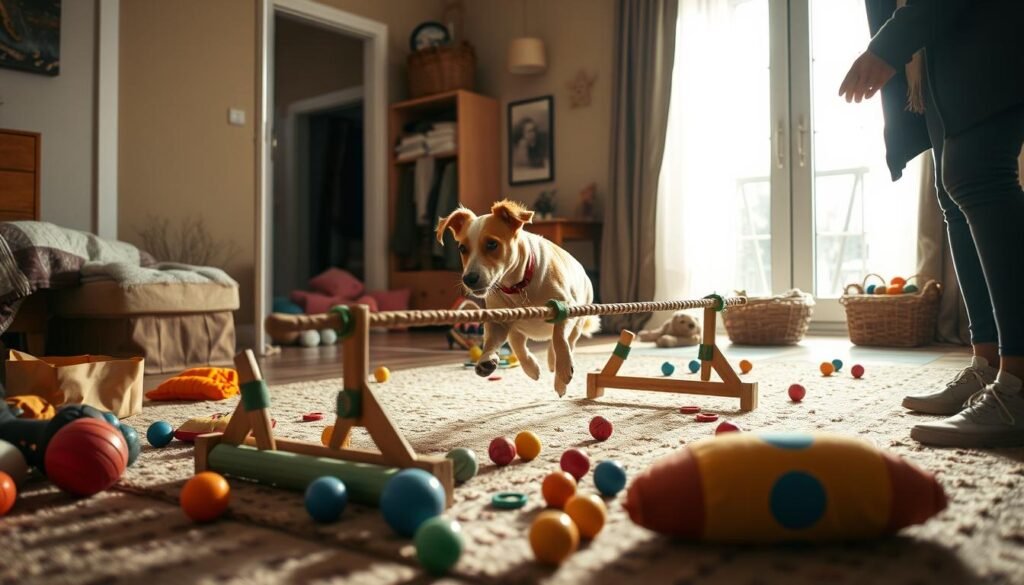
Make these activities a part of your daily routine. Your dog will stay active and sharp, no matter the weather. Indoor training improves obedience and problem-solving skills, making it essential and enjoyable for your dog.
Staying Safe During Outdoor Training Sessions
When you’re getting ready for outdoor dog training in the cold, it’s key to think about safety for both you and your dog. Cold weather dog training means making some changes to keep things safe and effective. First, think about visibility. Shorter days and cloudy skies can make it harder to see your dog. Use reflective gear or LED collars to keep them visible, even when it’s dark.
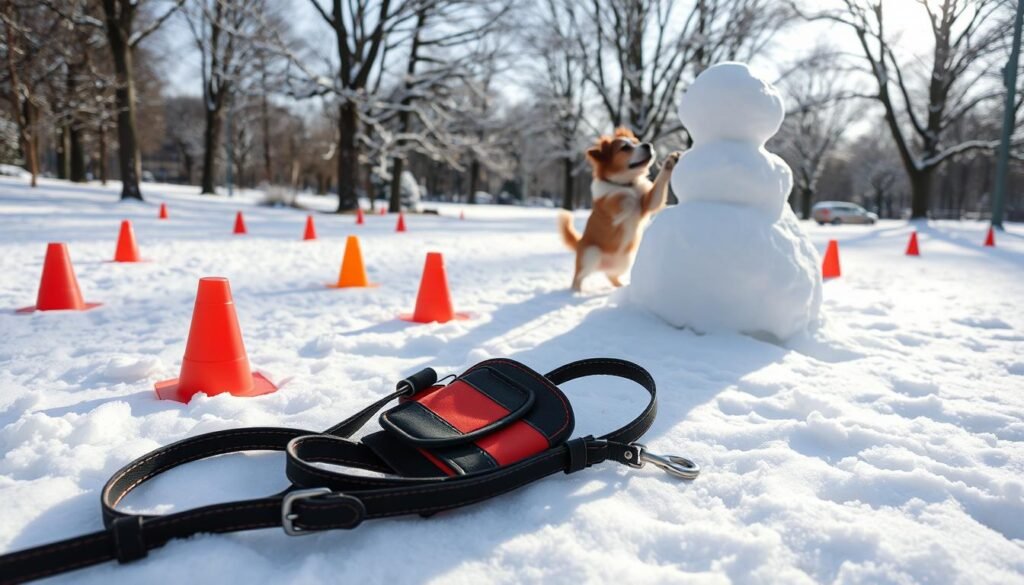
Winter dog walking tips stress the importance of watching your dog closely. Snow and ice can be slippery, leading to falls and injuries. Always pick safe, well-lit paths for walks and training. Also, watch for signs of cold stress or hypothermia, like shivering, anxiety, or not wanting to move. These signs mean you need to get them warm fast.
Timing is also important for safety and comfort. Try to train outside when it’s warmer, like during the day. This helps with visibility and keeps you and your dog from getting too cold.
Using these winter dog walking tips keeps your training sessions safe in the cold. This way, you and your dog can enjoy the winter without any problems. The secret to safe outdoor dog training in the cold is being prepared and knowing the dangers.
Behavioral Training and Managing Winter Blues
When it gets cold and dark, your dog might feel winter dog depression. The lack of outdoor fun can make them sad and change their behavior. But, dog behavioral training and some smart moves can help fight combating dog boredom in winter.
Mental games are as important as physical play. Try puzzle feeders, teach new tricks, or set up indoor obstacle courses. These activities keep your dog’s mind sharp and prevent bad behavior.
Even when it’s cold, you can still exercise your dog. Short walks often can keep them happy and active. On really cold days, play indoor games or use a dog treadmill to keep them busy.
Also, your presence can really comfort your dog. Spend time together, give extra hugs, and talk softly. These actions make your dog feel safe and loved, fighting off winter blues.
To keep your dog happy in winter, mix creative training, enough exercise, and lots of love. Follow these tips, and you and your dog will enjoy the winter season.
How to Keep Your Dog Motivated
When it gets colder and the days are shorter, keeping up with dog training can be tough. It’s important to keep your dog’s spirits up. Using dog training incentives is key to keeping them focused and eager to learn. Let’s explore some ways to motivate your dog and keep them excited about training during the cold months.
Varying the training activities is crucial for keeping your dog motivated. Try introducing new tricks and games. These should challenge their minds and keep them active. This variety makes each session exciting, boosting their enthusiasm.
Using dog training incentives can also boost motivation. Treats are great, but why not add more? Pair them with praise or extra playtime. These rewards affirm good behavior, making training fun and rewarding for them.
Lastly, keep your energy levels up. Dogs pick up on our emotions and can mirror our enthusiasm. Showing excitement during training makes the sessions lively. It also strengthens your bond, which is the best motivator.
Remember, motivating your dog and encouraging training in winter doesn’t have to be hard. With the right approach, it can be fun and rewarding for both of you. It’s filled with growth and joyful moments.
Adapting to Your Dog’s Winter Needs
Winter brings cold weather that changes how we care for our dogs. It’s important to adjust their diet, exercise, and living space for their comfort and health.
A warmer, nutrient-rich diet helps keep your dog’s energy up in the cold. Foods high in fats and proteins are great for winter. They give your dog the calories they need to stay warm and active. Make sure they have a cozy place to sleep, away from drafts and cold surfaces. Special dog beds or blankets that keep heat are perfect.
Winter also means wetter conditions, so grooming becomes more important. It prevents skin problems and keeps dirt and bacteria away. With shorter days, you might need to find indoor activities for your dog. Or schedule walks when it’s warmer.
Lastly, don’t forget to keep up with vet visits in winter. The cold can make health issues like arthritis worse in older dogs. Taking a proactive approach to winter care ensures a happy season for both you and your pet.
How to Adjust Training Goals for the Season
As winter comes, it’s key to set dog training goals that fit the cold weather. Short days and cold mean we need to adjust our training. This season, aim for realistic goals that make the most of winter’s unique conditions.
Start by checking where you are now and set small, achievable targets for winter. For example, if your dog knows basic commands inside, use winter to practice them outside in short sessions. This is about adapting to the environment and planning your training.
Also, think about how cold weather affects your dog. Add activities that keep them warm and active. This could be indoor agility or hide-and-seek games that challenge them while staying warm.
Remember, every dog is different in cold weather. So, part of setting dog training goals in winter is watching how your dog does with new activities. It’s about creating a space where your dog can do well in the cold.
Whether it’s new games or improving old tricks, make sure your goals are clear. Keep sessions short but regular. This keeps your dog excited and avoids training setbacks due to the weather.
Conclusion
As we finish our journey through winter dog training, we see many ways to succeed. The cold weather brings challenges but also chances to bond and learn. You and your dog can grow closer and understand each other better.
We’ve shared tips to keep your dog active and engaged, even when it’s cold. Being flexible with exercise and adapting training goals are key. These strategies are not just for the cold; they help your dog become well-rounded and adaptable.
As winter goes on, celebrate each achievement with your dog. Whether you’re outside or indoors, every effort makes your bond stronger. Stay committed, patient, and enjoy the special moments of winter dog training.
Quick Recommendation. Our blog is filled with tips and tricks for training your puppy or dog. If you’re seeking a comprehensive online training program, we recommend K9 Training Institute.

